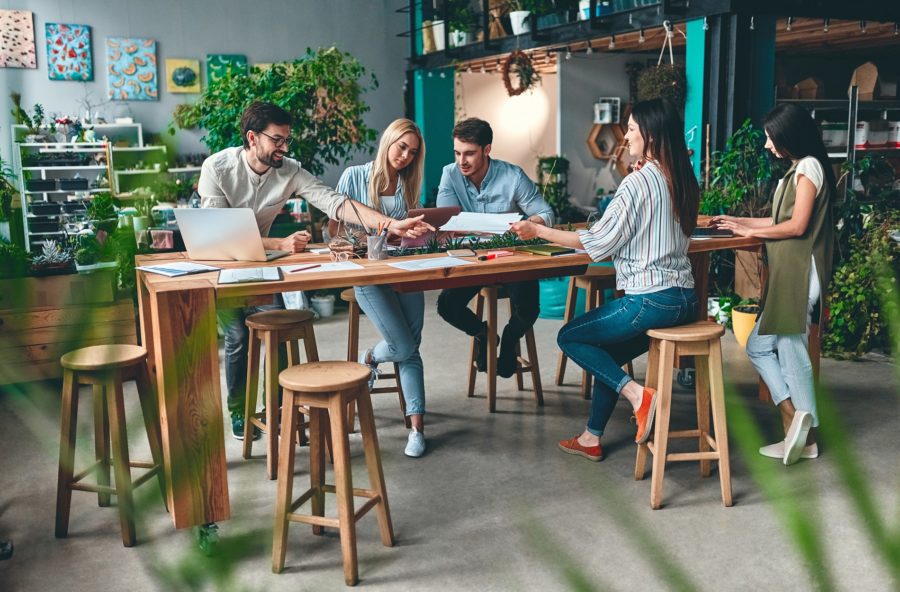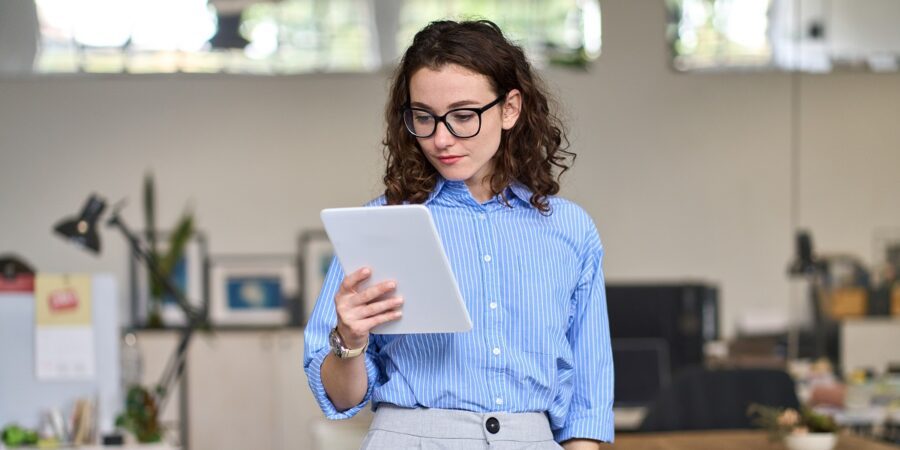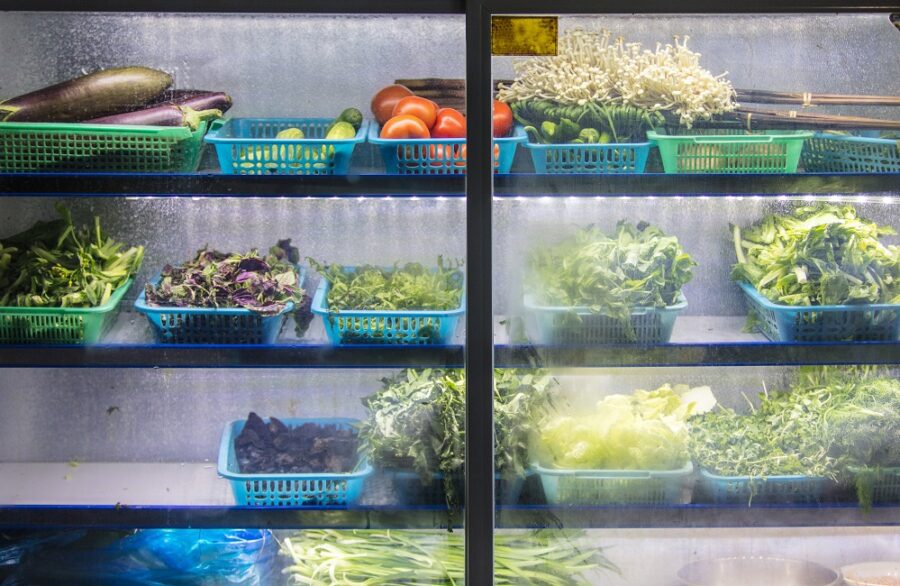
Commercial
Top 12 Corporate Office Design Trends in 2023
Written by: Parcel Pending
6 Min Read
Published: February 28, 2022
Updated: August 25, 2023
The current data suggests that with COVID-19 becoming an endemic vs. pandemic disease, employees might be back in the office in strong numbers this year. If so, here are the latest corporate office design trends and ideas to note:
#1 More Informal Conversational Areas
Since remote work demonstrated that many office jobs could be completed successfully at home, the goal of going into the modern office is often for informal discussions, collaboration, creativity, and company culture building. As a result, you’ll soon be seeing more café-type seating areas than meeting rooms. The Wall Street Journal recently reported that 60% of companies are redesigning their offices to accommodate the shift to hybrid work, with many eliminating private office spaces and devoting more space to café-like seating and open-space work areas.
As the authors adroitly observe in writing about the hybrid office in The Harvard Business Review: “ The latter will become primarily a culture space, providing workers with a social anchor, facilitating connections, enabling learning, and fostering unscripted, innovative collaboration.” If you are looking to increase collaboration and communication in the workplace, then an open office design is the perfect fit for your business.
#2 Modern Offices that Feel Like Home
Knowing that we got comfy and cozy in our elastic-waist pants over the pandemic, new offices and re-developed office spaces will reflect a home office-like atmosphere. Other office design ideas include plush carpeting, cushy couches, warm lighting, and even curtains!
#3 Office Designs with Health Considerations
Recognizing that COVID has become endemic, designers are incorporating health considerations for the interior space in new offices. What will those ideas look like? Expect to see office layout changes, such as more space between desks, surfaces that are easy to clean, and elevators installed with ultraviolet lighting that disinfects automatically. Buildings are also upgrading their HVAC systems to improve indoor air quality.
#4 Flexible Workspaces
Hot desking and activity based working have taken center stage as an office design trend. Simply put: hot desking is the term for non-dedicated, shared workspaces; employees have a different desk or space each time they visit the office. Of course, then, look to flexible furniture and hot desking equipment such as rolling whiteboards, file cabinets that double as a stool, height-adjustable desks, and mobile storage units to create “on the fly” workplaces. Google, for example, is experimenting with Team Pods to embrace this philosophy.
Flexible workspaces are designed so they can easily be converted from one purpose to another. For instance, a meeting room might quickly turn into an after-hours lounge area or an innovation zone.
#5 A Green Office Offering Plants & Sustainable Materials
Designers and management have recognized that plants are good for you and for them. Research suggests that a green workplace boosts efficiency and productivity in the workplace by 15%, helps clean the air, increases airflow, lowers toxins, and turns down the noise quotient.
As Manasa Kovvali Rao, Sustainability Data Manager and Researcher at WAP Sustainability Consulting explains: “Adding plants to an office space has multi-faceted benefits. Taking a break from stressful work and tending to plants can have a calming effect on the mind. It also brings workers closer to understanding seasonal variations and their effect on vegetation.”
Biophilic office interior design will also play a key role in office design in the new year. It simply means incorporating elements of nature into the workspace. A modern office design will include natural materials such as, bamboo, stone, waterfalls, and even fish tanks.
#6 Turning Down the Volume
Employees today are looking for a quiet and productive office space. Of course, noise reduction starts from the ground up, with carpeting acting as a good sound absorber. Certain vinyl flooring also works to mitigate noise. Phone booths have also emerged as a soundproofing lifeline for noisy co-workers.
#7 Embracing Smart Lockers
Smart office features and innovative office technology are shifting from amenities to necessities. Without permanently assigned desks or cubicles in the corporate space, there’s a need for safely and securely transferring documents, badges, laptops, and other physical resources. Enter Campus Hub™: a delivery model that leverages commercial lockers to allow for safe storage and retrieval of items within 10 seconds using a unique barcode from a user’s mobile phone. “Everyone wants to control their personal effects,” explains Jeffrey Gay, an architect and designer for MOI. “With the open office colliding with the hybrid workplace, you don’t always know who is in the space. You want to know that your things are safely locked away.”.
#8 Neutrals with Pops of Color
Beige and off-white walls continue to be great design ideas, especially in offices. They act as the neutral base layer for offices with bright pops of color added to doors, chairs, and window treatments.
#9 More Natural Lighting
Similar to employees racing to find outdoor space during the height of the pandemic, today, they’re looking for bright, natural light in the office environment to elevate their mood. Numerous studies demonstrate that natural light fends off depression, improves sleep, and overall improves health.
#10 Wallcoverings that Add Color and Texture
Say goodbye to the old image of wallpaper and hello to innovative ideas in wallcoverings for the modern corporate office. As noted by Paint & Color Trend Report: “Wallpaper can really liven up rooms. It can create a design focal point, add character to a space, and set the tone for the entire room.”
Office wall murals are popular and often represent elements of nature. Art deco wallpaper is a rising trend, and we expect to see more of it this year.
#11 An Active Workplace Environment
Gone are the days of static workstations and monotonous office routines. In 2023, companies are wholeheartedly embracing the concept of the active workplace environment, where employees can seamlessly transition between different work settings to suit their needs and preferences. This trend promotes movement, adaptability, and the use of ergonomic and active furniture, thereby enhancing employee engagement and productivity.
- Ergonomic Seating – Say goodbye to uncomfortable chairs that leave you feeling stiff and achy. These thoughtfully designed chairs offer adjustable features to support the natural curves of the spine, promote good posture, and reduce the risk of musculoskeletal disorders. With customizable lumbar support, adjustable armrests, and breathable materials, ergonomic chairs provide comfort and support for extended periods of sitting.
- Active Workstations – Sitting all day is a thing of the past. In 2023, active workstations are becoming the new norm. Height-adjustable desks allow employees to switch between sitting and standing positions and are gaining popularity. These desks enable employees to find their ideal ergonomic position, thereby improving circulation, reducing back pain, and boosting energy levels. Some advanced models even come with built-in treadmills or under-desk cycling machines, encouraging movement and physical activity while working.
- More Collaborative Spaces – The active workplace encourages collaboration and teamwork. To facilitate dynamic interactions, companies are incorporating collaborative spaces with ergonomic and active furniture. Think standing-height tables with adjustable stools or balance ball chairs. These alternative seating options not only promote movement but also foster a sense of informality and creativity. They provide employees with the flexibility to work together, share ideas, and engage in impromptu discussions.
#12 Including Transformed Lounge Spaces
Lounge spaces have transformed from simple break areas into opportunities to showcase a company’s values and culture. Companies understand the importance of fostering a positive work culture and providing opportunities for employees to unwind and recharge. They now feature better amenities and games to promote fun and relaxation. Common features in new lounge spaces include:
- Relaxation Pods – Lounge areas are now incorporating relaxation pods, where employees can take short power naps or simply find a moment of solitude. These cozy pods provide privacy, tranquility, and a chance to recharge, ultimately boosting productivity and mental well-being.
- Board Games – Classic board games like chess, Scrabble, or Monopoly are making a comeback in modern lounge spaces. They offer an opportunity for employees to engage in strategic thinking, problem-solving, and friendly banter. Board games also promote social interaction and create a relaxed and inclusive atmosphere.
- Ping Pong Tables – Table tennis is a popular game that encourages friendly competition and enhances hand-eye coordination. Ping pong tables in lounge areas create an atmosphere of excitement and camaraderie, where employees can engage in quick matches or tournaments during their breaks.
- Air Hockey – The fast-paced thrill of air hockey adds an element of excitement to lounge spaces. The competitive spirit is ignited as colleagues challenge each other in friendly matches, fostering team bonding and a sense of playfulness.
Hybrid working is here to stay and because of that employees need flexible, yet comfortable workspaces. Most importantly, they also need a dedicated space to stash their property, documents, or files which is where parcel locker systems play a pivotal role. To talk to a representative about how to design an electronic locker system for your office, contact a Parcel Pending representative today!



